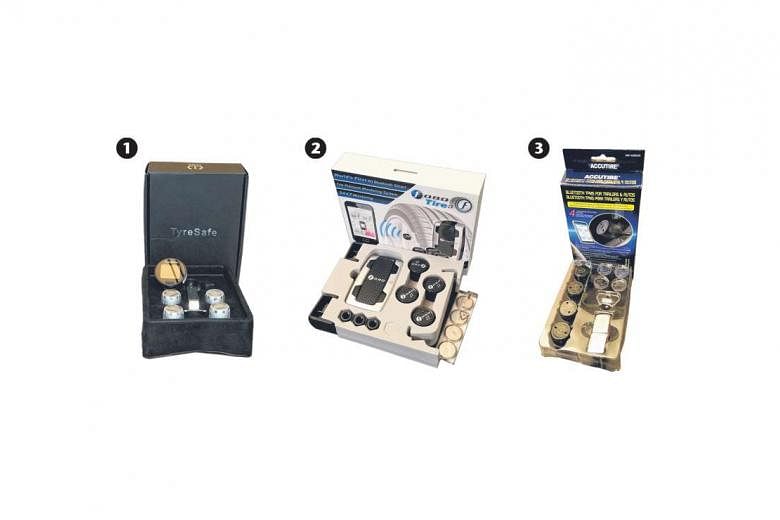There are many modern cars with tyre pressure monitoring systems, but there are many more without these.
To fit your car with an aftermarket system is not difficult.
Here are three to choose from: TyreSafe from local electronics firm Singtech; Fobo Tire Plus from Malaysia's Salutica Allied Solutions; and AccuTire from United States- based Measurement.
All three use button battery-powered sensors mounted on the tyre valve stems. The sensors need to be removed when the tyres are being refilled.
1. TyreSafe ($160)
This system consists of four sensors that wirelessly transmit tyre pressure information to a central receiver, and which has a quadruple array of two-digit displays plugged into the car's cigarette lighter socket.
You have to toggle a single button to display other data and create a custom preset warning for low pressure or over-inflation.
The pressure resolution indicated was 1.0psi and the readings were quite accurate compared to my usual handheld gauge.
What's good: Easy and secure set-up; the display is always on; lightest and smallest among the three.
What's not: One-button toggling is inconvenient; extra data is unnecessary, when tyre pressure is all you want.
2. Fobo Tire Plus ($310)
This one is cool because it includes an app that displays the pressure information on your smartphone. It is otherwise similar to the TyreSafe system.
Tire Plus has four sensors, whose signals are picked up by a central transceiver and sent via Bluetooth to your phone. The transceiver has its own power supply (two AA lithium batteries).
There is a less expensive $245 version called Fobo Tire, but its sensors read up to only 50psi, whereas the Fobo Tire Plus reads up to 87psi (which might be overkill).
The sensors are slightly bigger than the TyreSafe ones but smaller than the AccuTire ones. Fobo also offers a T-stem accessory that lets you pump air into the tyre without having to remove the sensor.
Once everything has been installed, launch the app, turn on the smartphone's Bluetooth function, and the tyre-pressure information goes live. Apart from pressure resolution (psi) readings, information such as date, time, temperature, battery status and, most pertinently, recommended tyre pressures are also displayed.
What's good: Fairly painless installation; handy smartphone pairing; the same phone app can be used for multiple cars; readings of 0.1psi are possible.
What's not: The app has to remain open for real-time information; you have to code and pair each sensor; high cost.
3. AccuTire ($100)
The easiest system to install of the three and is available on Amazon.
Each sensor is paired with the smartphone directly via Bluetooth, making a transceiver unnecessary. This explains the size and weight of the sensors, whose circuitry includes a short-range radio transmitter and a larger battery to supply the juice.
Once all four sensors are paired, information such as tyre pressure, tyre temperature and each sensor's battery status will be displayed. There is no date and time, though.
There is some lag because the phone inside the car has to struggle to connect with the four sensors outside via Bluetooth.
If the Bluetooth connection is good, each tyre's pressure is reported accurately, with a deviation of -1psi compared to readings from a handheld tyre pressure gauge.
The system has the potential to be the most cost-effective one here, but its value is compromised by its chunky sensors that lack anti-theft lock nuts, excessive bandwidth (25Mbps, sufficient for HD video streaming) that requires excessively heavy batteries, and inconsistent connectivity from my experience.
What's good: App-friendly; straightforward set-up; low cost.
What's not: Fiddly pairing with smartphone; sensors are clunky and its Bluetooth connection is inconsistent; easy to steal.
•The writer contributes to Torque, a motoring monthly published by SPH Magazines.

